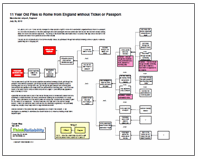Grain prices have more than doubled since the year 2003, even down from their record high prices in 2008. Grain is used for food, animal feed, and ethanol. The demand for grain for all of these uses is increasing, but the supply is not keeping up. This, along with other factors, has increased the price of grain to the point where it can be disastrous to the world’s poorest citizens.
We can examine the effect of the increased price of grain in a Cause Map. A Cause Map allows us to lay out cause-and-effect relationships in an easy to understand, visual format. To begin the Cause Map, we determine the impacts to the goals. In this case, because we are looking at the grain price increases for the years 2003-2012 worldwide, our goals are broad. The safety goal is impacted because there has been a high impact on the nutrition of the poor. Grain prices have led to food riots in many locations, which is another impact to the safety goal. The environmental goal has been impacted by the loss of usable cropland. The increase in food prices can be considered an impact to the customer service goal. Demand outpacing supply can be considered a production goal (considering the worldwide demand and supply). Lastly, the increase in the price of grain itself can be considered an impact to the property goal.
 Beginning with the safety goals: nutritional deficiency and food riots resulting from the increase in the price of food. The increase in the price of food affects the poor in two ways – it reduces individual buying ability and reduces the amount of food aid that can be bought for the same amount of money. In short, a country providing a consistent monetary amount of food aid will provide less aid when the food is more expensive. This double whammy is further worsened considering the impact of the cost of fuel – as it increases, even less food can be bought per aid dollar.
Beginning with the safety goals: nutritional deficiency and food riots resulting from the increase in the price of food. The increase in the price of food affects the poor in two ways – it reduces individual buying ability and reduces the amount of food aid that can be bought for the same amount of money. In short, a country providing a consistent monetary amount of food aid will provide less aid when the food is more expensive. This double whammy is further worsened considering the impact of the cost of fuel – as it increases, even less food can be bought per aid dollar.
The increase in the price of food is directly impacted by the price of grain. Grain is used as a food itself, as well as feed for animals that are used for food, and is a component of many other produced foods. The cost of all these foods go up as the price of grain increases.
Why is the price of grain increasing? There are many factors that result in the increase in the price of grain. Firstly the cost of grain goes up as the cost of the fuel needed to transport it and the cost of fertilizer needed to grow it increase. As the demand for fertilizer grows, the cost grows. The demand grows, as the demand for all crops grows.
The supply vs. demand equation also contributes to the cost of grain. When demand increases, and supply does not keep up, cost goes up. The demand for grain has been increasing – for food to feed the growing population, and to produce input-intensive foods, which actually require more grain. (For example, about 7 kg of grain are required to get 1 kg of beef. As the demand for input-intensive foods increases, the demand for grain increases even more.) The government mandates and subsidies that require the use of grain for bio-fuels – driven by the increasing cost of oil – also substantially increases the demand for grains. Making matters worse, in order to attempt to protect their population and agricultural industry, countries have been restricting exports and/or hoarding, further decreasing available supply for trade.
Demand is not keeping up with supply. The growth in agricultural productivity – which allows for a higher crop yield – has not increased as quickly as demand. Crops are lost to agricultural pests, droughts and floods, and a particularly virulent strain of steam rust fungus, which has affected many grain crops. Lastly usable cropland is being lost, due to urbanization to support that growing population, as well as erosion and water depletion, which can be impacted by poor land management. In many cases, the investment and infrastructure to allow for agricultural advances just isn’t there.
The issues discussed above become a vicious cycle, making solutions that much more difficult and important. Specifically, world organizations have asked countries to examine their agricultural policies, including ethanol mandates and subsidies, export restrictions and taxes, and hoarding. Work on advanced bio-fuels or Brazilian sugar cane ethanol can reduce the amount of agricultural land devoted to producing crops for biofuels, rather than food. Investment and development funds, as well as increased aid, are being sought to help remedy the current situation. Import taxes into many countries that have food shortages have been reduced or removed to try to reduce the cost of food. These are big solutions – for a big issue. It is estimated that 16% of the world’s population is chronically under-nourished. Further increases in the cost of food will only make the situation worse, without making some of the changes discussed here.
To view the Outline and Cause Map, please click “Download PDF” above. Or click here to read more about the crisis and actions taken by the World Bank.









